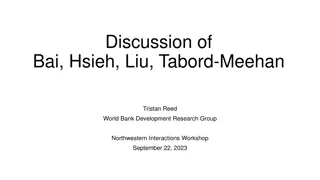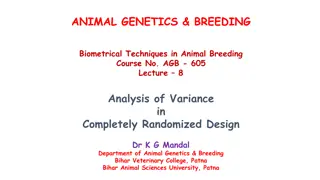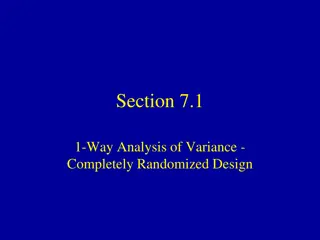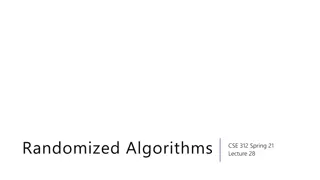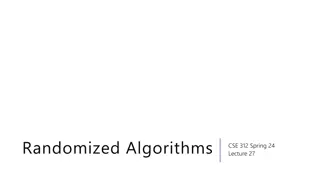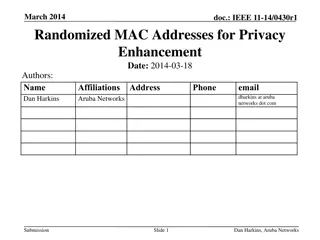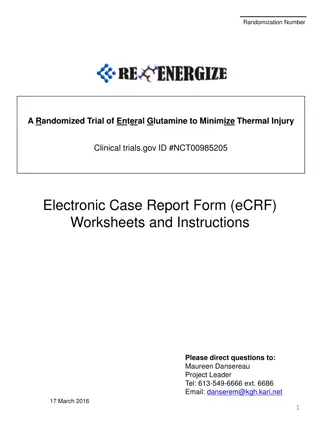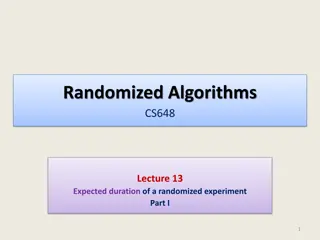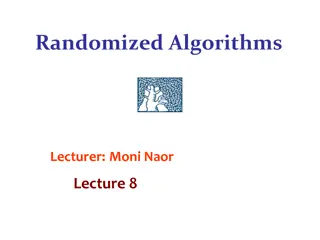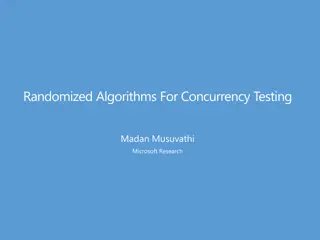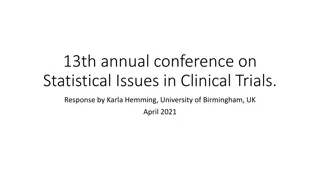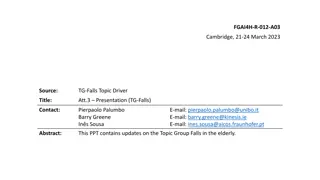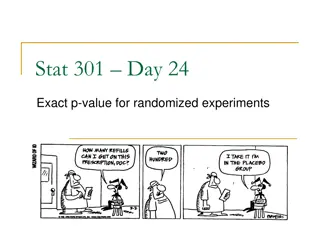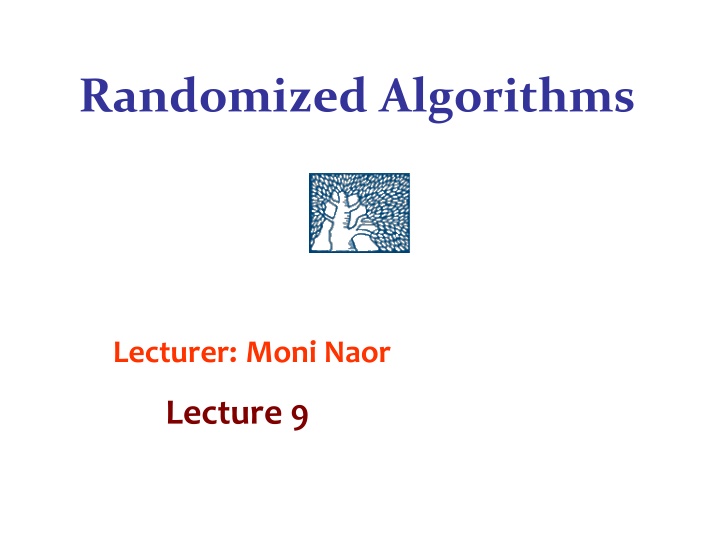
Randomized Algorithms Lecture Summary
Learn about randomized algorithms from the lecture by Moni Naor, covering topics such as Cuckoo Hashing, Bloom Filters, Random Graphs, and more. Understand the structure of proofs by compression or encoding and the complexities of inverting random functions. Explore the dynamic dictionary setting, space consumption terminology, and its applications in information theory.
Download Presentation

Please find below an Image/Link to download the presentation.
The content on the website is provided AS IS for your information and personal use only. It may not be sold, licensed, or shared on other websites without obtaining consent from the author. If you encounter any issues during the download, it is possible that the publisher has removed the file from their server.
You are allowed to download the files provided on this website for personal or commercial use, subject to the condition that they are used lawfully. All files are the property of their respective owners.
The content on the website is provided AS IS for your information and personal use only. It may not be sold, licensed, or shared on other websites without obtaining consent from the author.
E N D
Presentation Transcript
Randomized Algorithms Lecturer: Moni Naor Lecture 9
Recap and Today Today Cuckoo Hashing Proofs by compression Bloom Filters Random Graphs Limited Randomness and the Braverman s Result concerning AC0
Structure of Proofs by Compression or Encoding Relevant to both upper and lower bounds Consider a random string used in the system Could be The random function that should be inverted The randomness used by an algorithm Show that the event you want to bound implies a compression of the randomness Probability of compressing ? bits is 2 ? Hence: probability of bad event is bound by 2 ? Sometimes need extra randomness to help us
Proof by Encoding Inverting a random function is hard Given black-box access to a random function ?: 0,1? 0,1?and A challenge y 0,1? goal is to find x s.t f(x) =y Claim: number of queries needed is close to 2? Proof: Homework How to phrase exactly?
Proof by Encoding Given black-box access to a random function ?: 0,1? 0,1?and A challenge y 0,1? goal is to find x s.t ?(?) = ? Probability over what? Claim: number of queries needed is close to 2? Proof: Suppose can invert y within T steps with probability p for ? = ?(?) for random ? ? 0,1? Will use to compress ? to fewer than ?2?bits needed for random function Fix the inverter s bit as well as y Sequence of queries and answers ?1,?1, ?2,?2, ,(??,??) With probability at least p: one of the ?? s is y Savings: ? log? Only log T Bit to record Which one Only these recorded
The Setting Dynamic dictionary: Lookups, insertions and deletions Dynamic vs. static Performance: Lookup time Update time Memory utilization Related problems: Approximate set membership (Bloom Filter) Retrieval 6
Space Consumption Terminology Information theoretic bound : Implicit Data Structure: + O(1) Succinct Data Structure: + o( ) Compact Data Structure: O( ) Universe ? of size ?. Set size ?. For static dictionary: = log? ?
Major Problem in Hashing Based Schemes: Collisions Hash Tables Hash Function h Table T Direct access to memory Elementx should ``reside in T[h(x)] Unless |T| |U| ... T U Collision:two different elements with the same value under h
Dealing with Collisions Lots of methods Common one: Linear Probing Proposed by Amdahl Analyzed by Donald Knuth 1963 Birth of analysis of algorithms Probabilistic analysis 9
Linear Probing To insert x:try location h(x)in table T If occupied, try h(x)+1 and if occupied, try h(x)+2 Until we find a vacant place Looking for x: Similar to insert: search until finding x or a vacant place. 10
Linear Probing: situation after a while 11
Cuckoo Hashing: Basics Introduced by Pagh and Rodler (2001) Extremely simple: 2 tables: T1and T2 Each of size r = (1+ )n 2 hash functions: h1and h2 Lookup: Check in T1and T2 d ty h2(x) c x x a h1(x) b Where is x? ... ... z T2 T1 12
Cuckoo Hashing: Insertion Algorithm To insert element x, call Insert(x, 1) To insert x: Put in first location and displace residing element if needed Put displaced element in its other location Until finding a free spot Insert(x, i): 1. Put x into location hi(x) in Ti 2. If Ti[hi(x)] was empty: return 3. If Ti[hi(x)] contained element y: do Insert(y, 3 i) d ty Example: c x h2(y) = h2(a) b h1(e) = h1(a) a e ... ... z h1(y) T2 T1 13
Cuckoo Hashing: Insertion What happens if we are not successful? Unsuccessful stems from two reasons Not enough space The path goes into loops Too long chains Can detect both by a time limit. 14
Cuckoo Hashing: Deletion Extremely simple: 2 tables: T1and T2 Each of size r = (1+ )n 2 hash functions: h1and h2 As in Lookup: Check in T1and T2 Remove wherever found d ty h2(x) c x x a h1(x) b Where is x? ... ... z T2 T1 15
The Cuckoo Graph Set S U containing n elements h1,h2: U {0,...,r-1} Insertion algorithm achieves this Bipartite graph with |L|=|R|=r Edge (h1(x), h2(x)) for every x S Claims: S is successfully stored Every connected component in the cuckoo graph has at most one cycle Expected insertion time: O(1) occupied vacant 16
Why? A dense component: simply not enough places to put the elements No dense component: Tree: put elements towards the leaves Can pick any node as the root The root remains vacant Cycle: two possibilities Cycle plus trees: make the nodes on cycles the roots of the trees
Cuckoo Hashing: Properties Many attractive properties: Lookup and deletion in 2 accesses in the worst case May be done in parallel Insertion takes amortized constant time Reasonable memory utilization No dynamic memory allocation Lots of Generalizations Lots of applications to related problems Growing evidence of practicality on current architectures 18
Animation of Insertions T1 T2 h1( ) = 4 h1( ) = 8 h1( ) = 10 h1( ) = 4 h1( ) = 4 h1( ) = 8 h1( ) = 6 h1( ) = 2 h1( ) = 6 h1( ) = 10 h2( ) = 6 h2( ) = 8 h1( ) = 6 h1( ) = 2 h2( ) = 4 h2( ) = 1 h2( ) = 10 h2( ) = 4 0 1 2 3 4 5 0 1 2 3 4 5 Input h2( ) = 8 Queue 6 7 8 9 10 11 6 7 8 9 10 11 With queue for de- amortization 19
More than One Cycle With probability (1/n) Cuckoo Hashing fails Recall: connected component with more than one cycle Standard solution: rehashing Meaning: insertion worst case may be O(n) [KMW08] suggested stash Saves rehashing Actually reduces insertion worst case to O(log n) Constant-sized stash is sufficient whp Kirsch, Mitzenmacher, Wieder Prob of more than k: 1/nk+1 20
The Stash Because of stash, need also Cycle Detection Mechanism: Can accommodate log n elements Supporting O(1) lookups and resets Detecting second cycle as it happens ... Queue Cuckoo graph 21
Analysis: why Does it work? What is the probability of failure? How sparse does the table need to be? Where do the two cycles come into play? Probability of one cycle somewhere is constant: The Probability that there are ?1and ?2s.t. 1(?1) = 1(?2) and 2?1 = 2?2 is constant OTOH: Two cycles, small component: probability is small. Why? Encoding! Probability of saving ? bits for a random string is ? ?
Components in the Cuckoo Graph Order the components by the least numbered vertex Assign numbers in 1-n based on this ranking Ranking remains the same even if we remove some edges, as long as we do not disconnect a component ... Cuckoo graph
Two cycles, small component 2n log r bits on S Let 1and 2be random functions. The event that there is a small component with two cycles can be used to compress the encoding of 1and 2: Say the component is of size k. Find two edges, corresponding to elements a and b in S that do not disconnect the component. Write: a, b component index endpoints in component rest of the values of 1and 2on S\{a,b} Altogether: (2n-1) log r +4log k ... Saving is almost log r. Happens with probability 1/n Number them 1-n 2log n bits Where we use the small component log n bits 4log k bits 2(n-2)log r bits
Analysis: long walk What is the probability when inserting x that we need a chain of length k?
Analysis: long walk when inserting x Probability when inserting x that we need a chain of length k? 2n log r bits on S Let 1and 2be random functions. Let S be a set and x is inserted. Event B: ={insert(x) traverses a simple path of length k} If Boccurs: will save of (k) bits in description of 1and 2. elements of S Saving of k bits happens with probability 1/2? Replaced log r with log n The value k: ?(log?) bits prefix free The edges of the path, in order: (? 1)log? bits. The vertices of the path, in order: (? + 1)log? bits. The values of 1and 2for keys not on the path, in order: 2(? ?) log? bits.
WebDiarios de Motocicleta Mihai P tra cu (1982-2012) This is a nice idea that looks like another application of "Moser's Method," but there's something I don't quite get. In your encoding proof, H is entropy of the bitstring h(x_1),g(x_1),...,h(x_n),g(x_n). Can you recover this bitstring from the encoding? As far as I can see, you can discover which edges are in the Cuckoo graph, but not which keys generated those edges. Or did I miss something?
I haven't looked at Moser's paper, but, given the blog-hype it received, I sincerely hope he does something smarter than just expressing probabilities in encoding terminology. This is a trivial idea that I presume many people had. As for the encoding, an edge is identical to a key. In other words, I may assume that the keys are {1,...,n}. You notice how I always say that I am encoding an edge with lg n bits. To put it in your terminology, there are n edges h(x_i)-- g(x_i). I can encode which edge is involved in some subgraph using lg n bits. So I do indeed recover the h and g values for all edges.
Towards Limited Independence So far: truly random functions Really want: Succinct representation: o(n) Fast evaluation: O(1) Close-to-random behavior Approach: use k-wise independence for smallest k possible Good news: many such efficient constructions [Sie89, P03, DW03,...] But: does k-wise independence suffice for k < n? I.e., does analysis still hold? Siegel Dietzfelbinger, Woelfel stlin, Pagh 29
k-wise Independent Hash Functions Family H of hash functions {hi}hi H i hi : U [0,...,m-1] Definition: A family H of hash functions is k-wise independent if for any distinct x1,...,xk U and for any y1,...,yk [0,...,m-1]: Pr [h(x1)=y1^ h(x2)=y2^ ... ^ h(xk)=yk] = 1/mk h H 30
Boolean Circuits and Randomness Boolean circuit: DAG size fan-in n inputs, m outputs depth AC0circuit: poly size, constant depth, unbounded fan-in [LN90] conjecture: any function computable by depth d, size s circuit is fooled by (log s)d 1-wise independence Linial, Nisan Fooled: probability of outputting 1 close on both distributions 31
Bravermans Result Braverman (2009): Theorem: Theorem: Any AC0circuit is fooled by polylog(n)-wise distribution. Let C be circuit of depth d and size m. Let be r-independent distribution for r cd (log m)O(d2) Then C cannot tell from the uniform distribution. proved by Bazzi and Razborov Special case of DNF formulas Note: for m = nO(logn), r is polylog(m) 32
Back to Our Story: Limited Independence Recall: the randomness assumption in analysis used for two events: Event1: sum of sizes of connected components is larger than a threshold Event2: the number of stashed elements is larger than a threshold Each of these events: can be recognized by depth 3 circuit of size nO(log n) The technique is quite general: May be useful in similar scenarios For example, implies a similar result for [KMW08] h1(x1) h2(x1) h1(x2) h2(x2) h1(xk) h2(xk) ... ... ... ... ... ... Kirsch, Mitzenmacher, Wieder 0/1 33
Random Graphs Several models Erd s R nyi models G(n,p): n nodes, each edge exists with probability p G(n, M): n nodes, the graph is chosen uniformly at random from the collection of all graphs which have n nodes and M edges. The questions relevant to Cuckoo Hashing: What happens with very sparse graphs.
Properties of graphs in G(n,p) A graph generated by G(n,p): If np < 1, then a.s. no connected components of size larger than O(log(n)). If np = 1, then a.s. graph has a largest component whose size is of order ??/?. If np c > 1, where c is a constant, there is a.s. a unique giant component with a constant fraction of the vertices. No other component with more than O(log(n)) vertices. If ?? < (1 ?) ln?, a.s. isolated vertices and the graph is disconnected. If ?? > (1 + ?) ln?/?, then a.s. graph is connected. Also Hamiltonian!
Set Membership Recall the Dictionary data structure: Universe ? of size ?, Set ? ?,|?| = ? Build a data structure ? such that: For any ? ?:? ? = Yes For any ? ?:? ? = No Space usage: ? ? ? ? ? log ? log Information theoretic bound
Space Consumption Terminology Information theoretic bound : Implicit Data Structure: + O(1) Succinct Data Structure: + o( ) Compact Data Structure: O( ) For static dictionary: B= log? ?
Approximate Set Membership Universe ? of size ?, Set ? ?,|?| = ? Build a data structure ? such that: For all ? ?:Pr[? ? = Yes ] = 1 For all ? ?:Pr[? ? = Yes ] ? Probability taken over the randomness of the data structure. 1 ? As we will see, memory can be reduced: |?| ? log Notation: (?,?)-Bloom Filter
Approximate Set Membership Construction Reduce the problem to exact membership: ? ?be chosen from a universal hash function. Store the set ? = { ?1, ?2, , ??} in an (exact) dictionary. For any ? ?: Union bound Let :? = ? ? Pr ? ? ? Pr ? = ?? ?= ? If a succinct dictionary is used: The non standard construction ?/? ? = ?log1 ? log ?+ ?(?) [CFGMW78]: Larry Carter, Robert Floyd, John Gill, George Markowsky, Mark Wegman
Construction using Cuckoo Hashing Simpler: static case Choose a pair-wise independent hash function g(x) In addition to h1 and h2 g(t) g(d) h2(x) g(y) g(c) g(x) x g(a) h1(x) g(b) There is a false positive if g(x) happens to be equal to one of two values ... ... g(z) T2 T1 Isx in S? Compare to g(x)
Bloom Filters Traditional Presentation m An {0,1} array A of size m k hash functions (what type?) Initial: all zero s in A On insertion: turn ?[??(?)] to 1 Search: verify that all ? ?? 1, 2, ? 0 0 0 = 1. O.w. say no The probability that a specific bit is still 0 after n insertions is ?? 1 ? ? ??/?. 1 false positive prob 1 2 ? 0.6185?/? The probability of a false positive is then Optimal choice (1 ? ??/?) ^? For given n and m the optimal choice of k is k = (ln 2) (m/n)
Some advantages of bit representation Very easy to produce an approximate representation of Union of sets. Intersection of sets
Using Permutations to Save Space Invertible Permutations Can use (x) as new identity of x Prefix of new name identity of cell/bin Know the prefix when the cell is probed ... 3 1 2 m ... 3 1 2 m 43
Approximate Set Membership Lower Bound Idea: Use the data structure to encode the set ? Length of encoding must be log? ? ? ? ? Create a data structure ?. The data structure A specifies a set ? of size at most ?? + ?. Those on which A says yes Encode ? relative to ? : ?? + ? ? ? n log1 False positives True positives ? ? ? + log log ? ? ? Encoding of S relative to ? + S ?
Applications Many and very common in practice: Databases, networking, SPAM filtering and more Common practice: cache Approximate the cache s content External Web Filter: Request Web Proxy Cache Approximation of the Cache
A Succinct Dictionary A succinct and efficient dictionary is given in [ANS10]: Constant time operations in worst case w.h.p. log? Succinct representation using 1 + ? 1 ?bits. When storing ? additional bits for each element space becomes: ? ? 1 + ? 1 log + ??
Communication Complexity Protocol Variants Communication Complexity Protocol Variants Deterministic complexity is often ? Example: equality Protocols differ by Network layout Who talk to who and number of rounds Interactive Model Simultaneous Message Model Use of Randomness Shared public randomness Independent of the inputs Private Randomness Orthogonal! SMMPC: Simultaneous Message Model with Private Coins 48
Simultaneous Messages Model Simultaneous Messages Model y x ?? ?? ?? ?? ?(??,??) Probability of error: ? f(x,y) No shared randomness: Private Coins 49
Simultaneous Equality Testing Simultaneous Equality Testing x y n C(y) C(x) n1/2x n1/2 C should be a good error correcting code Communication ?(?1/2) 50
Simultaneous Messages Model: Lower Bound Newman-Segedy 96 |??| + |??| = ? Babai-Kimmel 97 |??| |??| = ? x y In general: Deterministic complexity ?? ?? ?? ?? Bottesch, Gavinsky, and Klauck 2015 ?(??,??) f(x,y) 51


